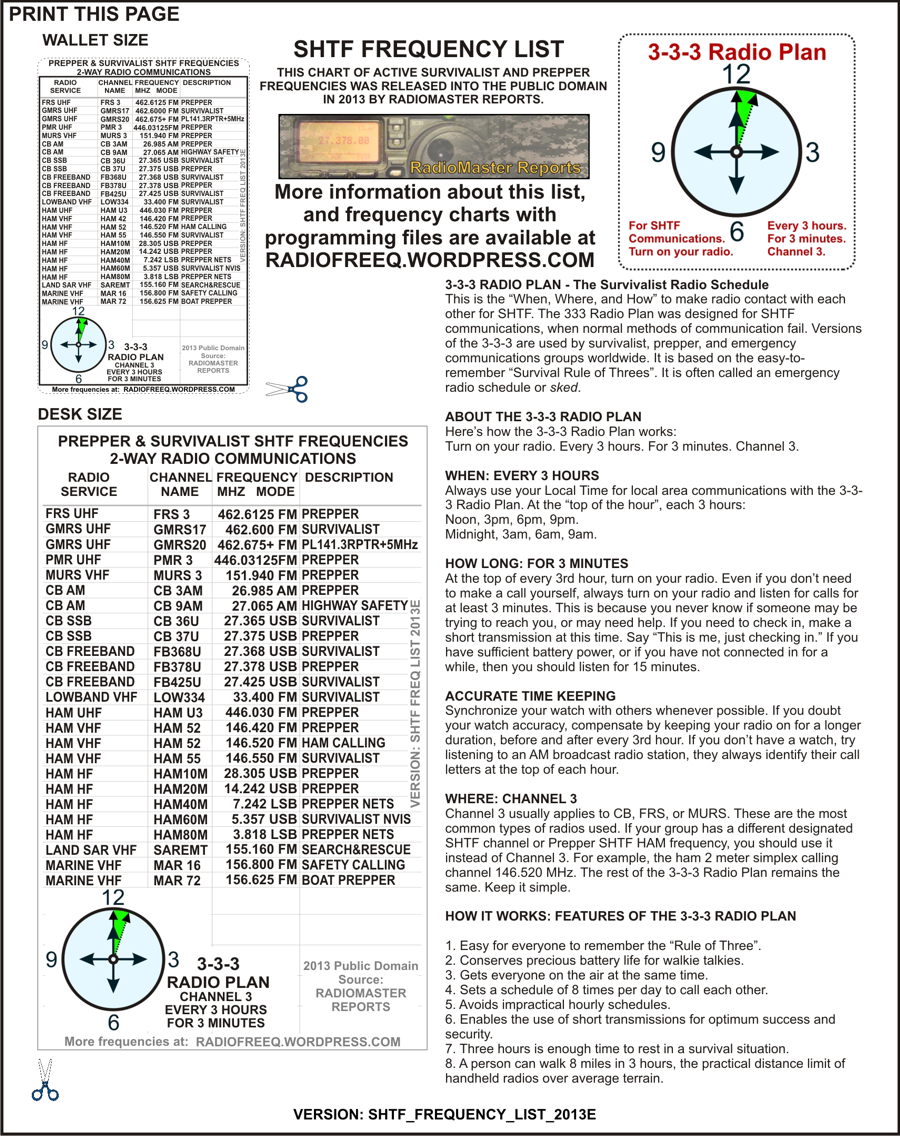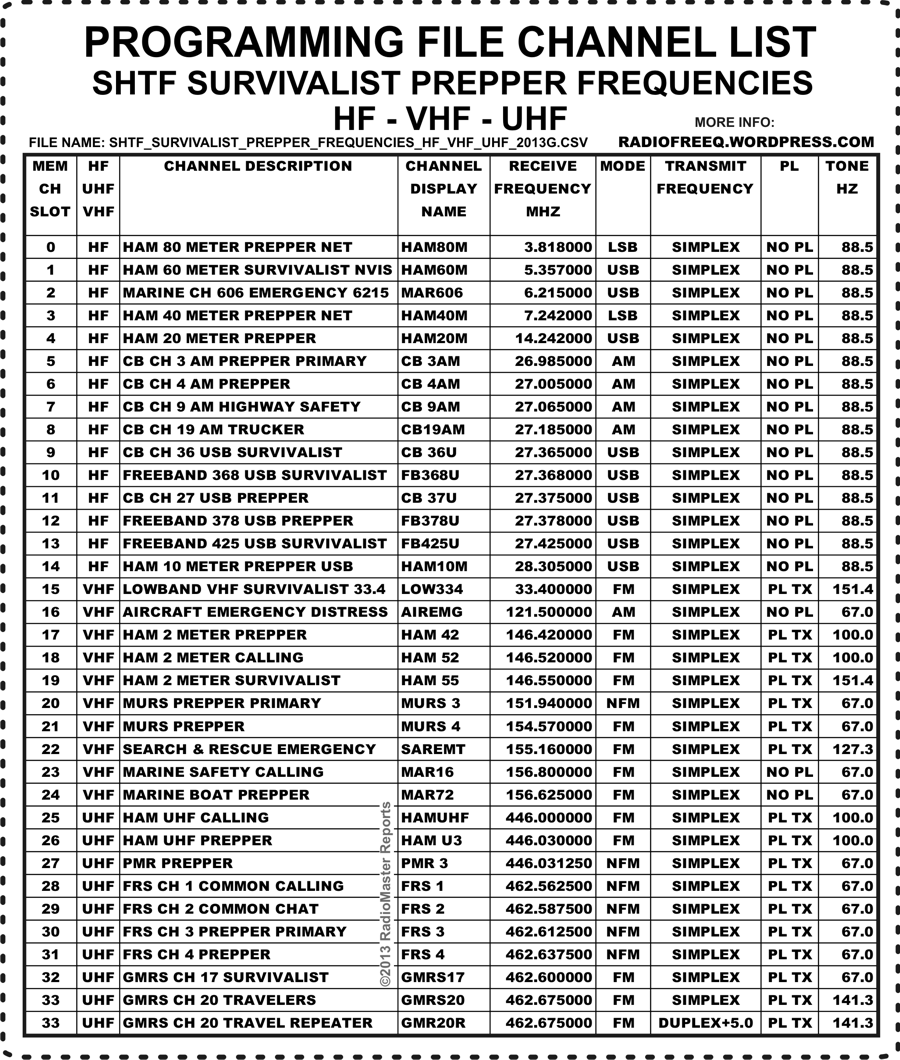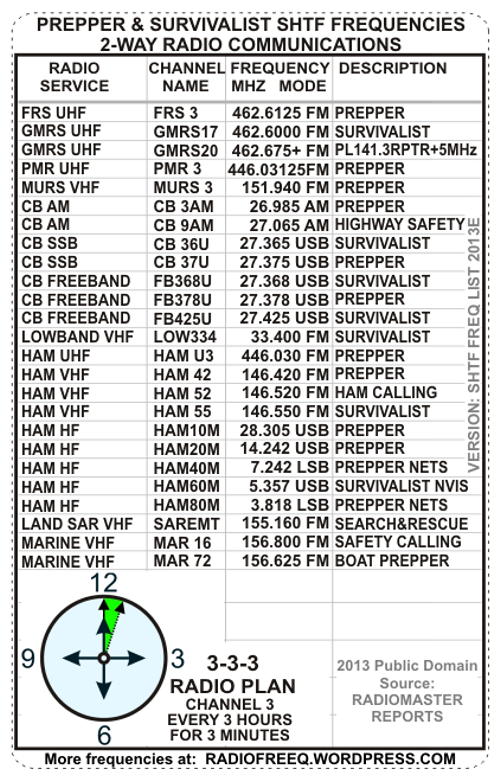Any avid off-roader knows that radio communications is an important part of wheeling. Especially if you are wheeling with a group of people. Radio communications is also a vital part of SHTF / survival situations.
When it comes to radio communications, you have different options:
- CB (Citizens Band) Radio
- GMRS (General Mobile Radio Service)
- FRS (Family Radio Service)
- MURS (Multi-Use Radio Service)
- Ham Radio (Amateur Radio Service)
- Ham Radio 2-Meter
Most truck enthusiasts have a CB radio mounted in their truck. Some use Ham Radio, and some use FRS/GMRS hand held radios. They use them for basic communications with other people / vehicles in their group.
We’re going to discuss further the different types of radios (frequency ranges) and why you should, or maybe should not, have them.
CB (Citizen Band Radio)
CB radios have been around since the 1970’s. They’re a cheap form of communication and can be easily found for purchase.
Range can be a mile to several miles depending on terrain, proper antenna tuning, and power output. Power output is generally 4-watts, but some people have increased the power to increase its range.
The channels / frequencies:
| CB Frequency | CB Channel | Customary Use |
| 26.96500 | CB Channel 01 | open to all |
| 26.97500 | CB Channel 02 | open to all |
| 26.98500 | CB Channel 03 | open to all |
| 27.00500 | CB Channel 04 | open to all–4×4 channel |
| 27.01500 | CB Channel 05 | open to all |
| 27.02500 | CB Channel 06 | open to all |
| 27.03500 | CB Channel 07 | open to all |
| 27.05500 | CB Channel 08 | open to all |
| 27.06500 | CB Channel 09 | Emergency |
| 27.07500 | CB Channel 10 | open to all–regional roads |
| 27.08500 | CB Channel 11 | open to all |
| 27.10500 | CB Channel 12 | open to all |
| 27.11500 | CB Channel 13 | open to all–marine, RV |
| 27.12500 | CB Channel 14 | open to all–walkie talkies |
| 27.13500 | CB Channel 15 | open to all |
| 27.15500 | CB Channel 16 | open to all (also SSB) |
| 27.16500 | CB Channel 17 | open to all–North/South Traffic |
| 27.17500 | CB Channel 18 | open to all |
| 27.18500 | CB Channel 19 | Truckers–East/West Hwy Traffic |
| 27.20500 | CB Channel 20 | open to all |
| 27.21500 | CB Channel 21 | open to all–regional roads |
| 27.22500 | CB Channel 22 | open to all |
| 27.25500 | CB Channel 23 | open to all |
| 27.23500 | CB Channel 24 | open to all |
| 27.24500 | CB Channel 25 | open to all |
| 27.26500 | CB Channel 26 | open to all |
| 27.27500 | CB Channel 27 | open to all |
| 27.28500 | CB Channel 28 | open to all |
| 27.29500 | CB Channel 29 | open to all |
| 27.30500 | CB Channel 30 | open to all |
| 27.31500 | CB Channel 31 | open to all |
| 27.32500 | CB Channel 32 | open to all |
| 27.33500 | CB Channel 33 | open to all |
| 27.34500 | CB Channel 34 | open to all |
| 27.35500 | CB Channel 35 | open to all |
| 27.36500 | CB Channel 36 | open to all (also SSB) |
| 27.37500 | CB Channel 37 | open to all (also SSB) |
| 27.38500 | CB Channel 38 | open to all (also SSB, LSB) |
| 27.39500 | CB Channel 39 | open to all (also SSB) |
| 27.40500 | CB Channel 40 | open to all (also SSB) |
Common channel uses:
- Channel 3 – Unofficial Prepper channel
- Channel 4 – 4×4 groups
- Channel 9 – Emergency channel / Highway Patrol
- Channel 19 – Over the road truck drivers
- Channel 37 – Unoffical prepper channel
GMRS (General Mobile Radio Service)
GMRS Radios are generally found as handheld radios but can also be found as mobile radios. They’re reasonably priced and have a range of 2-miles for hand helds, and 5-miles for mobile radios. Because of their high frequency range, they are more of a line of site radio, so they are greatly affected by terrain and obstacles.
- Most GMRS radios are 5-watts, but they can legally operate up to 50-watts.
- The range can be increased using repeaters.
- GMRS radios require a license to use.
- Most GMRS radios are also programmed with FRS frequencies.
- Channel 3 – Prepper / Survivalist channel
A radio repeater is a combination of a radio receiver and a radio transmitter that receives a weak or low-level signal and retransmits it at a higher level or higher power, so that the signal can cover longer distances without degradation.
FRS (Family Radio Service)
FRS radios are found as small handheld radios. They’re easily found in most sporting goods stores and stores like Walmart. They do not require a license to use. Their range is generally under 2-miles.
- FRS radios only operate at 1/2-watt, which is why they have such a short range.
- Channel 3 – Prepper / Survivalist channel
A radio repeater is a combination of a radio receiver and a radio transmitter that receives a weak or low-level signal and retransmits it at a higher level or higher power, so that the signal can cover longer distances without degradation.
FRS / GMRS Frequencies
Note: Channels 1-14 are FRS and channels 15-22 are GMRS
| GMRS Simplex Channels and Frequencies | |||
|---|---|---|---|
| Channel | Frequency | Max Power | Bandwidth |
| 1 | 462.5625 | 5W | 25kHz* |
| 2 | 462.5875 | 5W | 25kHz* |
| 3 | 462.6125 | 5W | 25kHz* |
| 4 | 462.6375 | 5W | 25kHz* |
| 5 | 462.6625 | 5W | 25kHz* |
| 6 | 462.6875 | 5W | 25kHz* |
| 7 | 462.7125 | 5W | 25kHz* |
| 8 | 467.5625 | 0.5W | 12.5kHz |
| 9 | 467.5875 | 0.5W | 12.5kHz |
| 10 | 467.6125 | 0.5W | 12.5kHz |
| 11 | 467.6375 | 0.5W | 12.5kHz |
| 12 | 467.6625 | 0.5W | 12.5kHz |
| 13 | 467.6875 | 0.5W | 12.5kHz |
| 14 | 467.7125 | 0.5W | 12.5kHz |
| 15 | 462.5500 | 50W | 25kHz* |
| 16 | 462.5750 | 50W | 25kHz* |
| 17 | 462.6000 | 50W | 25kHz* |
| 18 | 462.6250 | 50W | 25kHz* |
| 19 | 462.6500 | 50W | 25kHz* |
| 20 | 462.6750 | 50W | 25kHz* |
| 21 | 462.7000 | 50W | 25kHz* |
| 22 | 462.7250 | 50W | 25kHz* |
| GMRS Repeater Channels and Frequencies | ||||
|---|---|---|---|---|
| Channel | RX Frequency | TX Frequency | Max Power | Bandwidth |
| RPT15 | 462.5500 | 467.5500 | 50W | 25kHz* |
| RPT16 | 462.5750 | 467.5750 | 50W | 25kHz* |
| RPT17 | 462.6000 | 467.6000 | 50W | 25kHz* |
| RPT18 | 462.6250 | 467.6250 | 50W | 25kHz* |
| RPT19 | 462.6500 | 467.6500 | 50W | 25kHz* |
| RPT20 | 462.6750 | 467.6750 | 50W | 25kHz* |
| PRT21 | 462.7000 | 467.7000 | 50W | 25kHz* |
| RPT22 | 462.7250 | 467.7250 | 50W | 25kHz* |
*Note: 20kHz Authorized Bandwidth.
Check out this FRS/GMRS Frequency Chart
MURS (Multi-Use Radio Service)
MURS radios are 2-watts and are said to have a range of up to 5-miles. They are not as powerful as GMRS radios, but offer more power than FRS radios, and do not require a license
| Channel | Frequency MHz |
| 1 | 151.820 |
| 2 | 151.880 |
| 3 | 151.940 |
| 4 | 154.570 |
| 5 | 154.600 |
This radio is more commonly used by businesses that don’t require a lot of range. These would be places like campgrounds, parks, hotels, etc where it’s all in one general location. Businesses choose these because they don’t require a license to use.
Channel 3 – Prepper / Survivalist channel
Ham Radio (Amateur Radio Service) 2-Meter
2-Meter Ham radio (VHF) offers the longest range and the clearest reception. A basic ham radio will have a 30-mile range but can talk much farther with the use of repeaters. These radios require a license, and you must take a test to get the license. The 2-meter is the most popular Ham radio and operates in the 144.000-148.000 MHz range.
Another popular Ham radio is the 70-cm (UHF) operating in the 420.000-450.000 MHz range.
Ham Radio Options:
Dual receive – Some radios actually have two radios built in one. This allows you to monitor two stations at once and switch between them at will. This is very useful for monitoring a repeater for very long-distance communication, while still talking to your friends on a simplex channel. It’s not a must have, but most will find it very useful. Some of these radios will even let you use them as repeaters (cross band repeat), but don’t worry too much about that if it doesn’t make sense. It’s mostly useful to listening to two frequencies at once.
Single, Dual, Triband, or Quad+ radio – The first thing you’ll need to decide is if you want a dual (or even tri) band radio or not. The two most used frequency groups in ham radio are 2m and 70cm (aka 440). There are many excellent and inexpensive 2m only radios. However, you will severely limit your access to repeaters if you choose to get a radio that does not support the 70cm frequency. This doesn’t mean there aren’t a lot of repeaters on 2m, but 70cm is very popular for repeater use as well. Most of the time while on the trail or traveling with friends we all use 2m simplex (radio to radio communications). If that’s all you care about and you’re willing to deal with losing access to some 70cm repeaters, just get a 2m single band radio. As for tri-band radios and above, I do not recommend them to most people. 6m and other frequencies available to tech licensees aren’t highly used by others at this time and it can make antenna configurations more complex. If you’ve got the money, go for it! It can’t hurt to have too much access to additional options, but it’s something most will never use.
PL, CTCSS, “encoding” oh my! – All modern radios will support Privacy “tones”. These are tones at a certain frequency that will give you access to repeaters and special equipment listening for communication with that signal. You WANT a radio that supports this. Without it you’ll be limited mostly to simplex only. This is only a concern if you are looking at much older radios in the used market. Make sure it has tone capability for use with repeaters! It has other uses as well, but this is the most important one. CTCSS is usually the technology keyword you should look for. DCS is also common in some radios and is the digital equivalent of the tone-based CTCSS system. Don’t worry if the radio doesn’t support DCS, it’s not commonly used at this time.
Channels:
Prepper channel (VHF) = 146.420
Survivalist channel (VHF) = 146.550
Prepper channel (UHF) = 446.030
Amateur (Ham) Radio License Tests:
You’ll need to take a test to get a license to use your Ham radio. All tests are simple multiple choice written tests. The two most popular licenses in the US are listed below and must must be taken sequentially.
Technician class – This will get you the basic privileges. There are lots of options with this “basic” class and it will give you what you need to talk well over 30 miles in many areas. It’s not the ultimate emergency tool like the general license is, but it will allow you to communicate very long distances to call for help, or talk to others operators. The test is VERY easy, and over 1/2 of it is common sense about safety. Most people will pass with ease even if they bomb every single math question on the test. With that said, if you can divide and multiply, then you’ll ace the math stuff as well. Take some practice exams and see for yourself.
General class – This is where you really step up your distance of communication. General class is all about HF (or high frequency) privileges. HF has better distance propagation than what you see in the Tech privileges, and at higher power in some instances. This is the license you want if you need to talk long distances under your own power. It is the ultimate in emergency communications. Radios requiring this class come at greater complexity and cost. The test and math requirements are quite a bit higher than the tech exam, but nothing extremely difficult. Most of these tests are memorization of frequencies and law. There is a lot more focus on circuit design and understanding of components in this test. While not impossible, it will take a lot more studying.
3-3-3 Radio Plan (Survivalist Radio Schedule)
The 3-3-3 radio plan should be remembered and used by anyone with a 2-way radio. The object is simple:
- Turn your radio on every 3-hours starting at midnight;
- Tune your radio to channel 3
- Listen for 3-minutes.
If you have an emergency and transmit on channel 3 (whether it’s CB, GMRS/FRS, etc) for 3-minutes every 3-hours, there should be someone out there listening.
References:
Here are some good references / guides for you to print out.



Resource:
Survivalists Radio Frequency Lists
Jim Oaks is the founder of TheRangerStation.com, the longest-running Ford Ranger resource online since 1999. With over 25 years of hands-on experience building and modifying Ford Rangers — including magazine-featured builds like Project Transformer — Jim has become one of the most trusted authorities in the Ford Ranger off-road and enthusiast space. In 2019, he was loaned a Ranger FX4 by Ford Motor Company to test and document across the TransAmerica Trail. Jim continues to inspire and guide Ranger owners around the world.
